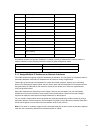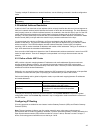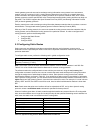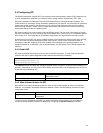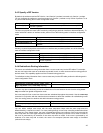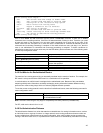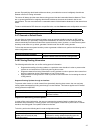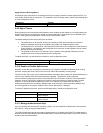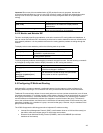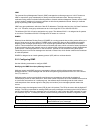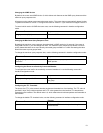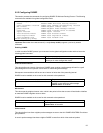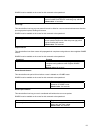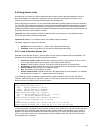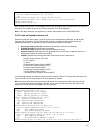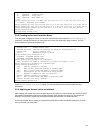
49
Important!
Do not use plain text authentication in RIP packets for security purposes, because the
unencrypted authentication key is sent in every RIP Version 2 packet. Use plain text authentication when
security is not an issue (for example, to ensure that incorrectly configured hosts do not participate in
routing).
Command Purpose
ip rip authentication mode
{text | md5}
Configure the interface to use MD5 digest
authentication or let it default to simple password
authentication.
ip rip authentication string
string
Set the interface with plain text authentication. The
string must be shorter than 16 characters.
5.4.12 Monitor and Maintain RIP
The user can display specific router statistics, such as the contents of IP routing tables and databases, in
order to monitor and maintain RIP. Information provided can be used to determine resource utilization and
solve network problems. It is also possible to discover the routing path the packets are taking through the
network.
To display various router statistics, perform the following tasks in top mode.
Command
Purpose
show ip rip
Display general information about RIP routing
processes in a particular router.
show ip protocols
Display the parameters and current state of the active
routing protocol process.
To quickly diagnose problems, the debugging commands are useful to users. Use the following commands
in privileged top configuration mode to display information on RIP routing transactions.
Command
Purpose
debug ip rip events
Display RIP events including sending and receiving
packets and changes in interfaces.
debug ip rip packet [recv |
send]
debug ip rip packet
[
recv
|
send
]
detail
Display detailed information about the RIP packets.
The information includes the origin and port number
of the packet as well as a packet dump.
show debugging rip
Show all information currently set for RIP debug.
5.5 Configuring IP Multicast Routing
Multicast traffic is a means to transmit a multimedia stream from the Internet (a video conference, for
example) without requiring a TCP connection from every remote host that wants to receive the stream.
Traditional IP communication allows a host to send packets to one host (unicast transmission) or to all hosts
(broadcast transmission). IP multicast provides a third scheme, allowing a host to send packets to a group of
hosts (group transmission). A multicast address is chosen for the members of a multicast group. Senders
use that address as the destination address of a datagram to reach all hosts of the group. The stream is
sent to the multicast address, and from there it’s delivered to all interested parties on the Internet. Any host,
regardless of whether it is a member of a group, can send to that group. However, only the members of the
group receive the message.
The IC35516 supports the following protocols to implement IP multicast routing:
• Internet Group Management Protocol (IGMP): used between hosts on a LAN and the router(s) on
that LAN to track the multicast groups of which hosts are members
• Distance Vector Multicast Routing Protocol (DVMRP): used on the MBONE (the multicast
backbone of the Internet)



